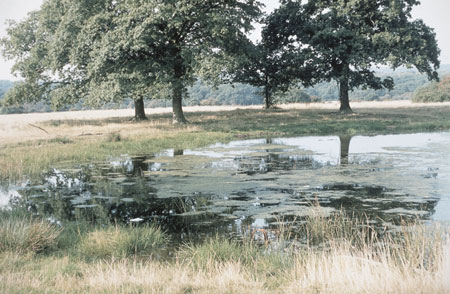2.1.4 Nitrate in natural water
Nitrate in water arises from excessive fertiliser use, as a waste product from many organisms and natural decay. The nitrate level in natural water is important as excess nitrate may cause problems from eutrophication. This is when the ecological balance of a body of water such as a lake is disturbed by excessive growth of algae at certain times of year. As the weather gets colder, the growth ceases, and the algae sink and decay, consuming oxygen dissolved in the water. This can result in an unpleasant smelling lake (largely due to the production of hydrogen sulfide) and, in an extreme case, the fish in the lake can die from oxygen starvation. Figure 6 shows algal growth in eutrophic water.
In drinking water the recommended maximum level for nitrate provides a safeguard against the disorder methaemoglobinaemia, which is potentially fatal for infants younger than six months. The toxicity occurs because the nitrate is reduced to nitrite (NO2−) which then interferes with the mechanism of transporting oxygen around the body by the protein haemoglobin. This reduction of nitrate is often associated with bacteria.
What is the change in the nitrogen oxidation number on going from nitrate to nitrite?
The nitrogen is reduced from an oxidation number of +5 to +3.
Excess nitrate can be removed in water treatment by ion-exchange chromatography (IEC, Figure 7) involving here water as the so-called mobile phase. IEC is based on a chromatography technique whereby dissolved species, or solutes, are adsorbed to varying extents onto the ionic sites of a so-called stationary phase which is an ion-exchange medium or resin (grey circle in Figure 7). One ionic species (the solute) is substituted for another from the stationary phase. If negatively charged ions are exchanged, it is called anion-exchange chromatography; the exchange of positively charged ions is called cation-exchange chromatography.
The stationary and mobile phases are chosen to selectively retain ionic species. The ionic strength of a solution is a function accounting for the concentration of all the different ions. By changing the ionic strength of the mobile phase, the ions in Figure 7 are eluted, or extracted into the mobile phase (here water), from the stationary phase. The ions bound by the stationary phase are eluted in order of the strength of binding, the most weakly bound ions being eluted first. The binding strength of the ions with the stationary phase depends on the differences in charge and charge density of the various ions present.
Here, nitrate ions are exchanged with chlorides on an ion-exchange resin (represented as R* in Equation 17 and as grey circles in Figure 7, see also Section 2.2.1):
Beads of the medium or ion-exchange resin contain a covalently bound group holding a positive charge, for example R−N(CH3)4+X− where R is a polymeric resin and X− is an anion which can be exchanged.
Why do you think the ion-exchange resin is regenerated by eluting with a concentrated sodium chloride solution? (See Figure 7)
With a high concentration of chloride ions the nitrate ions are exchanged and the initial chloride form of the ion-exchange resin is regenerated:
R*-NO3 + Cl−(aq) = R*-Cl + NO3−(aq)(Equation 18)

